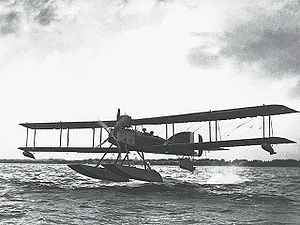Short 184
| Type 184 | |
|---|---|
 |
|
| Role | Reconnaissance aircraft / Torpedo bomber |
| Manufacturer | Short Brothers |
| Designer | Horace Short |
| First flight | 1915 |
| Introduction | 1915 |
| Retired | 1933 (Estonia) |
| Primary users |
Royal Naval Air Service Royal Flying Corps Hellenic Navy Estonian Air Force |
| Number built | 936 |
| Variants | Mann Egerton Type B |
The Short Admiralty Type 184, often called the Short 225 after the power rating of the engine first fitted, was a British two-seat reconnaissance, bombing and torpedo carrying folding-wing seaplane designed by Horace Short of Short Brothers. It was first flown in 1915 and remained in service until after the armistice in 1918. A Short 184 was the first aircraft to sink a ship using a torpedo, and another was the only British aircraft to take part in the Battle of Jutland.
Torpedo-dropping trials had been undertaken using a 160 hp (120 kW) Gnome powered Short Admiralty Type 166 but this had proved insufficiently powerful, and so in September 1914 a new specification was formulated for an aircraft to be powered by the 225 hp (168 kW) Sunbeam Mohawk engine currently being developed. Design proposals were invited from Sopwith, J. Samuel White and Short Brothers. Horace Short's response when the requirements were explained him by Murray Sueter, the director of the naval air department, was to say "Well, if you particularly want this done, I will produce a seaplane that will satisfy you", and on the strength of this assurance two prototypes were ordered, for which serial nos. 184 and 185 were reserved, the resultant type so becoming the Type 184.
Similar in basic design to earlier Short floatplanes built for the Navy, the Type 184 was an equal-span three-bay tractor configuration biplane. The fuselage was a conventional wire-braced wooden box-girder, with spruce longerons spindled out to reduce weight and fittings of manganese steel. The top surface of the fuselage was faired to a semi-circular section. The engine was mounted on bearers fixed to pressed steel transverse frames mounted between the longerons and the large rectangular radiator was mounted above and behind the engine, directly in front of the upper wing.
...
Wikipedia
